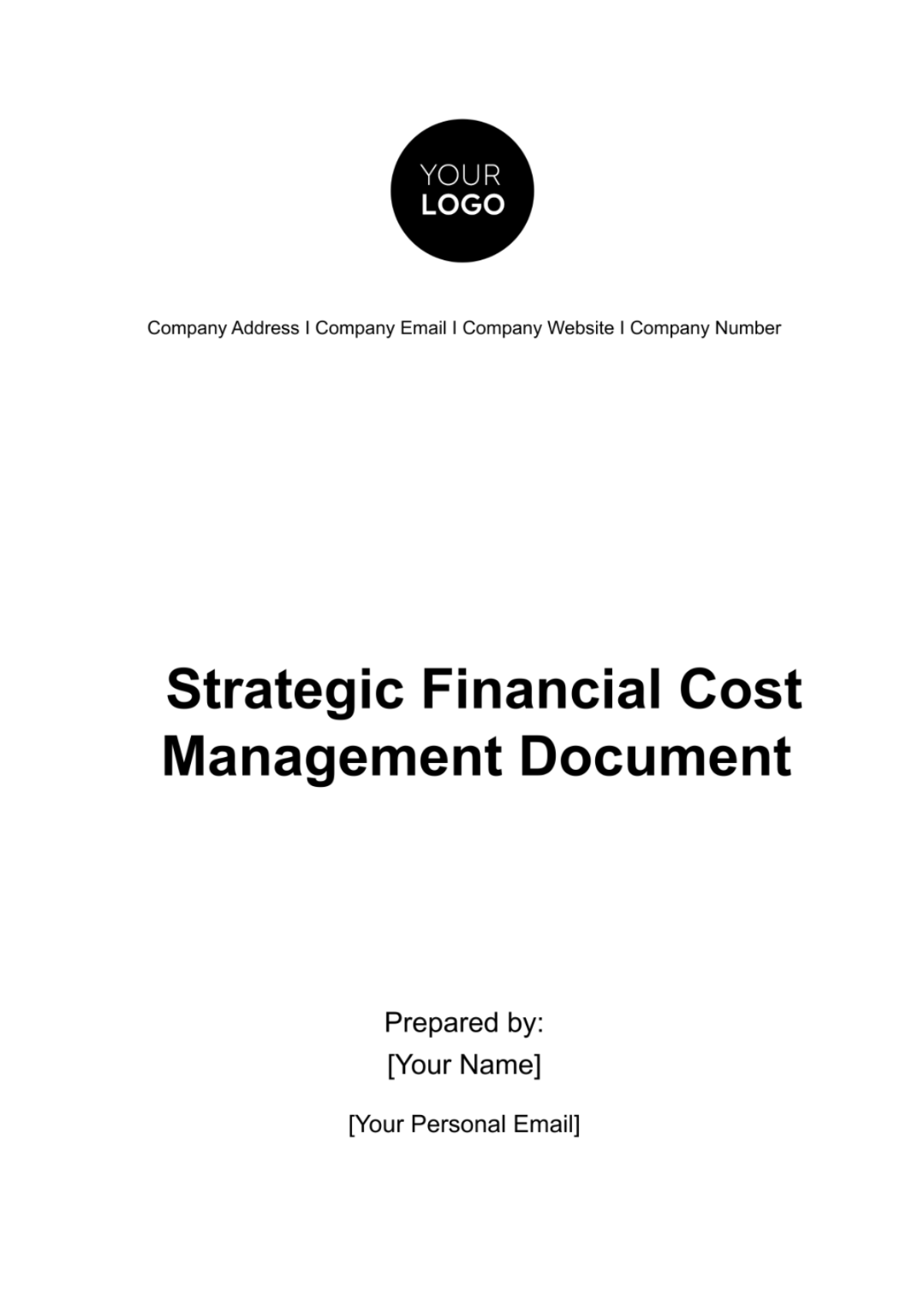Free Strategic Financial Cost Management Document

Executive Summary
This Strategic Financial Cost Management document outlines our comprehensive approach to optimizing the company's financial performance. Key objectives include enhancing cost efficiency, maximizing investment returns, and mitigating financial risks. We aim to achieve these through a combination of meticulous financial analysis, strategic cost management, and prudent investment portfolio management. This plan is designed to position the company for sustainable growth and increased shareholder value over the long term.
Table 1: Key Objectives and Strategies
Objective | Strategy |
Cost Efficiency | Implement process automation, renegotiate supplier contracts |
Investment Returns | Diversify portfolio, identify high-yield opportunities |
Risk Mitigation | Financial risk assessment, hedging strategies |
Financial Analysis Overview
Current Financial Position
Our financial analysis begins with a comprehensive review of the current financial position of the company. This involves examining cash flows, profit margins, revenue streams, and overall financial health.
The current financial position reveals a stable cash flow situation, with a consistent increase in profit margins over the past three years. Revenue streams are diversified, with a notable increase in digital services contributing to recent growth. However, there are areas for improvement in cost management and asset utilization.
Table 2: Financial Ratios and Assets
Financial Ratios | Current Value | Industry Average |
Return on Assets | 8.5% | 7.2% |
Current Ratio | 1.8 | 2.0 |
Debt to Equity | 0.6 | 0.7 |
Historical Performance Review
An in-depth review of the company's historical financial performance is crucial to understanding trends, making informed forecasts, and identifying areas of strength and weakness.
Analysis of the past five years shows a steady growth in revenue, with an average annual increase of 4.5%. The profit margin has improved from 12% to 15% over the same period, indicating effective cost management. However, investment returns have been inconsistent, suggesting a need for a more strategic approach to portfolio management.
Table 3: Year-over-Year Financial Comparison
Year | Revenue | Profit Margin | Investment Return |
Year 1 | $100M | 12% | 5% |
Year 2 | $105M | 13% | 4.8% |
Year 3 | $110M | 14% | 3.5% |
Year 4 | $115M | 14.5% | 5.2% |
Year 5 | $120M | 15% | 6.0% |
Cost Reduction Techniques
Our approach to cost reduction is multifaceted, focusing on both immediate savings and long-term efficiency.
We are targeting a 10% reduction in operational costs over the next fiscal year. This will be achieved through a combination of measures such as optimizing supply chain logistics, introducing automation in repetitive tasks, and renegotiating contracts with key suppliers. A task force will be established to identify and implement these cost-saving measures across various departments.
Table: Estimated Cost Savings by Department
Department | Current Cost | Projected Savings | New Estimated Cost |
Manufacturing | $5M | $500K | $4.5M |
Marketing | $2M | $300K | $1.7M |
Administration | $1M | $200K | $800K |
Investment in Cost-Efficient Technologies
Investing in technology can lead to significant long-term savings by increasing efficiency and reducing manual labor costs.
We plan to invest in advanced analytics tools and automation technologies. These investments are expected to streamline operations, enhance data-driven decision-making, and reduce reliance on manual processes. The initial focus will be on automating data entry and analysis tasks in the finance and accounting departments.
Table: ROI Projections for Technology Investments
Technology | Initial Investment | Expected Annual Savings | Payback Period |
Analytics Software | $500K | $100K | 5 Years |
Automation Tools | $750K | $150K | 5 Years |
Investment Analysis
Portfolio Management Strategies
A comprehensive strategy for managing the company's investment portfolio is crucial for maximizing returns while controlling risk.
Our portfolio management strategy will prioritize diversification to minimize risk. We will rebalance our portfolio semi-annually, focusing on a mix of high-growth potential stocks, stable income-generating bonds, and emerging market opportunities. This approach aims to achieve a balanced risk-return profile in line with our financial goals.
Table: Current Portfolio Distribution
Asset Type | Percentage of Portfolio | Risk Level |
Stocks | 50% | High |
Bonds | 30% | Medium |
Alternative Investments | 20% | Medium to High |
Future Investment Opportunities
Identifying and capitalizing on future investment opportunities is key to sustaining growth and profitability.
We are exploring opportunities in green energy and technology sectors, given their potential for high returns and alignment with our sustainability goals. Additionally, we will evaluate emerging markets for expansion, particularly in Asia and Africa, where economic growth rates are promising.
Table: Potential Investment Opportunities Evaluation
Opportunity | Expected Return | Risk Level | Alignment with Company Goals |
Green Energy Projects | 12% | Medium | High |
Technology Startups | 15% | High | Medium |
Emerging Markets | 10% | High | Medium |
Financial Risk Assessment
Effective risk management is crucial for maintaining financial stability and safeguarding assets.
Our financial risk assessment focuses on identifying potential risks related to market volatility, credit, liquidity, and operational factors. We are conducting a comprehensive analysis to evaluate the impact and probability of these risks. This will involve scrutinizing market trends, assessing counterparty credit risk, and reviewing internal operational processes.
Table: Risk Assessment Matrix
Risk Type | Probability | Potential Impact | Mitigation Strategies |
Market Volatility | High | Moderate | Diversification, Hedging |
Credit Risk | Medium | High | Credit Analysis, Insurance |
Liquidity Risk | Low | High | Cash Reserves, Credit Lines |
Operational Risk | Medium | Moderate | Process Improvements, Training |
Mitigation Strategies
Developing strategies to mitigate identified risks is essential to protect the company's financial health.
Our risk mitigation strategies include diversifying investments to buffer against market volatility, establishing stringent credit checks to manage credit risk, maintaining adequate liquidity reserves, and enhancing operational procedures to minimize operational risks. Additionally, we are exploring insurance options to cover substantial financial exposures.
Table: Cost-Benefit Analysis of Mitigation Strategies
Strategy | Estimated Cost | Benefit | Implementation Timeline |
Diversification | Minimal | High Risk Reduction | Ongoing |
Credit Insurance | $100K annually | High Risk Reduction | 1 Year |
Liquidity Reserves | $500K | High Financial Stability | 6 Months |
Operational Improvements | $200K | Increased Efficiency | 1 Year |
Implementation Plan
Short-term Initiatives
Immediate actions are outlined to kick-start our strategic financial management plan.
In the short term, our focus will be on implementing cost-saving measures and initiating the risk mitigation strategies. This includes automation projects in key departments, renegotiating contracts, and setting up a risk management team. These initiatives are designed for quick implementation and immediate impact on our financial health.
Table: Short-term Initiative Timeline
Initiative | Department | Start Date | Completion Date | Expected Outcome |
Automation | Finance | Q2 2050 | Q4 2050 | Efficiency Increase |
Contract Renegotiation | Procurement | Q3 2050 | Q4 2050 | Cost Reduction |
Risk Management Team Setup | All | Q2 2050 | Q3 2050 | Risk Mitigation |
Long-term Strategic Goals
Our long-term goals are aimed at sustaining and advancing the company's financial position.
Over the long term, we are committed to growing our investment portfolio, continuously enhancing our risk management framework, and fostering a culture of financial efficiency and innovation. These goals will be supported by ongoing training, technology upgrades, and market analysis to ensure that our financial strategies remain relevant and effective.
Table: Long-term Goals and KPIs
Goal | Key Performance Indicator (KPI) | Target Date |
Portfolio Growth | 10% Annual Return | 2055 |
Enhanced Risk Management | 20% Reduction in Risk Incidents | 2054 |
Financial Efficiency | 15% Reduction in Operational Costs | 2053 |
Conclusion
This document encapsulates our comprehensive strategy for Strategic Financial Cost Management. It underscores our commitment to robust financial health, sustainable growth, and long-term shareholder value. The strategies outlined here, from cost management to investment analysis, are crafted to enhance our financial standing while mitigating risks effectively.
We recognize that the financial landscape is constantly evolving, and our approaches must be adaptable. This strategy is not just a response to current challenges but a proactive plan for future opportunities. We believe the implementation of these strategies will lead to improved profitability, enhanced operational efficiency, and a stronger competitive position in the market.
- 100% Customizable, free editor
- Access 1 Million+ Templates, photo’s & graphics
- Download or share as a template
- Click and replace photos, graphics, text, backgrounds
- Resize, crop, AI write & more
- Access advanced editor
Optimize your financial strategy with the Strategic Financial Cost Management Document Template from Template.net. This editable, customizable document facilitates strategic planning and execution of cost management. Essential for businesses seeking to balance expenditures with growth, it provides a framework for identifying cost-saving opportunities while maintaining operational effectiveness.





























